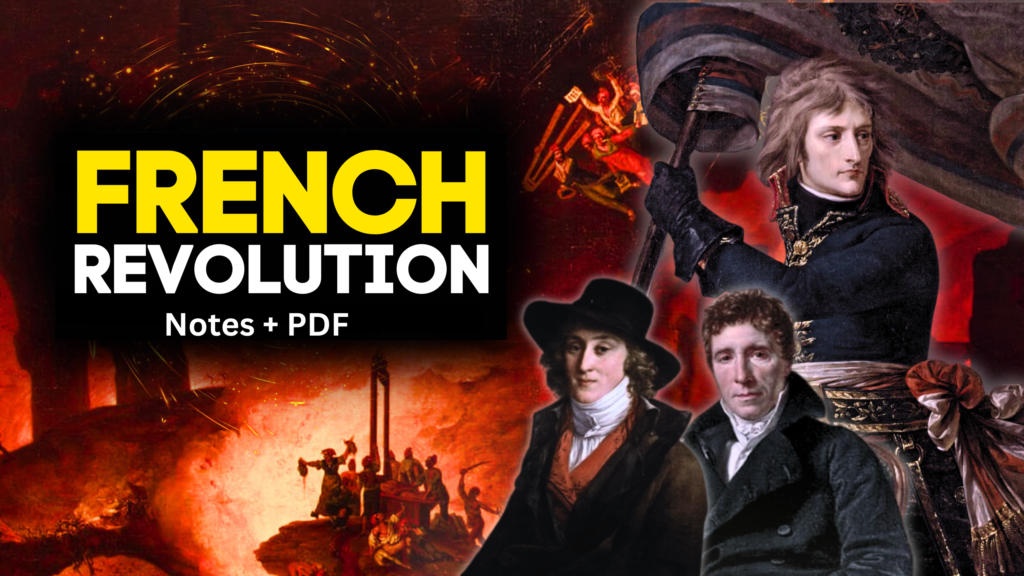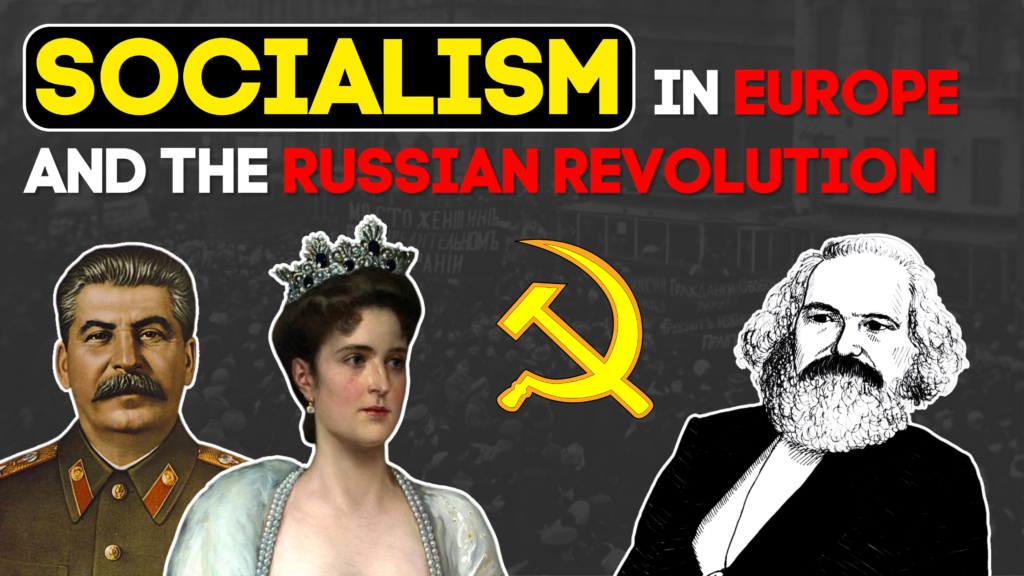- French Society During the Late 18th Century
- First Estate (the Clergy)
- Second Estate (the Nobility)
- Third Estate
- The Struggle to Survive
- A Growing Middle Class
- The Outbreak of the Revolution
- National Assembly of Third Estate
- Revolt Starts at the Bastille
- France Becomes a Constitutional Monarchy
- The Laws Made by the National Assembly
- France Abolishes Monarchy and Becomes a Republic
- The Jacobin Club
- The Reign of Terror
- A Directory Rules France
- Women in Revolution
- Laws Passed to Improve Women’s Lives
- French Women Got the Right to Vote
- Olympe de Gouges (1748-1793)
- The Abolition of Slavery
- The Revolution and Everyday Life
- Conclusion
- The French Revolution Notes PDF
- PRINTING Notes: The French Revolution
Greetings, friends! Welcome to etutorguru. Within this piece of writing, we have furnished CBSE Notes for Class 9 History Chapter 1, “French Revolution” Using these resources can help students perform better in exams.
The French Revolution is a game-changer in European and global history. It brought an end to France’s monarchy. The French Revolution’s slogans of liberty, freedom, and equality became important ideas of the new era.
French Society During the Late 18th Century

- Louis XVI of the Bourbon family was crowned King of France in 1774. He was married to Princess Marie Antoinette of Austria.
- When Louis XVI became king, he inherited an empty treasury. The main reasons for it were long years of war and the upkeep of the court of the Palace of Versailles.
- Louis XVI aided thirteen American colonies in gaining independence from the United Kingdom. As a result, the debt was increased by more than 1 billion livres, bringing it to more than 2 billion livres. Lenders who provided credit began charging a 10% interest rate on loans.
- To cover expenses such as maintaining the army, the court, running government offices and universities, and so on, the state was forced to raise taxes.
- However, this measure was insufficient because, in the 18th century, French society was divided into three estates, and only members of the third estate paid taxes.
- The estate’s society was a component of the mediaeval feudal system. Prior to 1789, France’s society and institutions were considered an old regime.
First Estate (the Clergy)

- It is made up of a group of people who have specific roles in the Church. They possessed vast amounts of land and wealth.
- They were born with certain advantages, such as the exemption from paying state taxes.
- The Church imposed a ‘Tithe’ tax on peasants, equal to one-tenth of agricultural produce.
Second Estate (the Nobility)
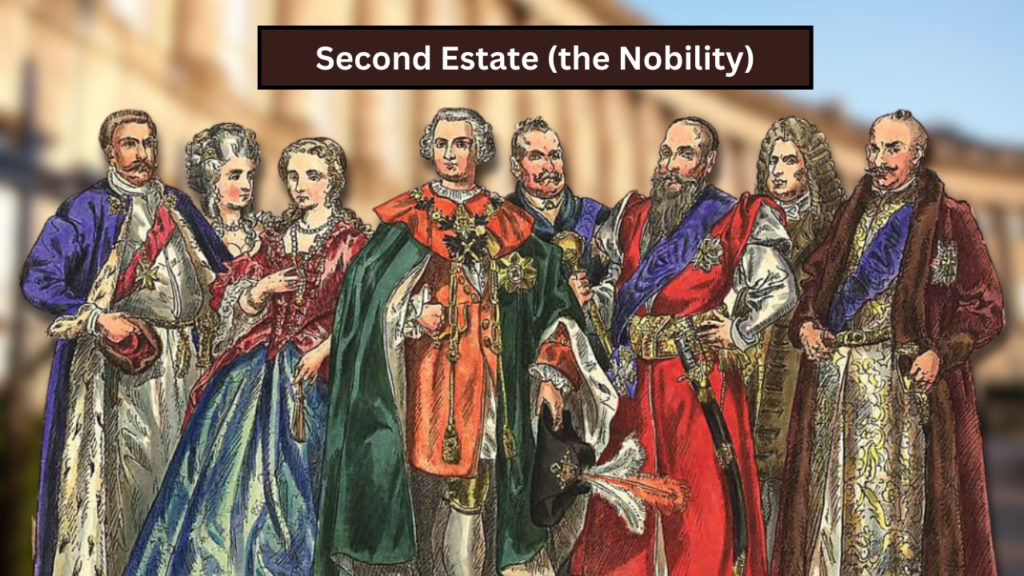
- It was made up of wealthy, aristocratic citizens of the state. They also had the advantage of not having to pay state taxes.
- They benefited from feudal privileges, such as feudal dues collected from peasants.
Third Estate
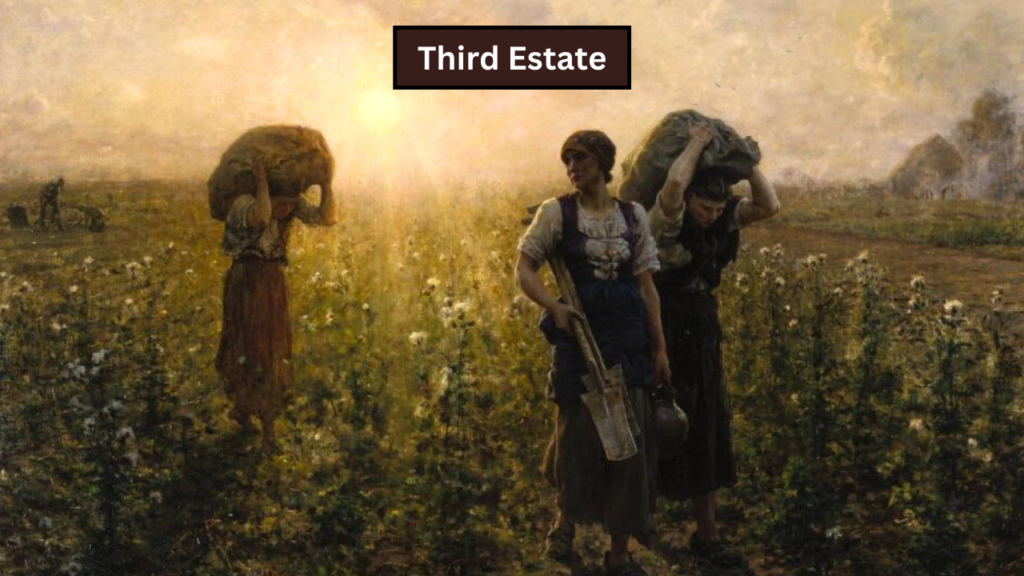
- It included the rest of the population, which included businessmen, merchants, court officials, lawyers, peasants, artisans, landless labourers, and so on.
- They had no privileges because they had to pay direct taxes to the state known as Taille as well as several indirect taxes levied on everyday items such as salt, tobacco, and so on..
- Peasants made up roughly 90% of France’s population. Only a few of them owned the land on which they farmed.
- Nobles, the Church, and other wealthy members of the third estate owned 60% of the land.
- Peasants were forced to work in nobles’ houses and on their lands, serve in the army, or help build roads.
The Struggle to Survive
- France’s population increased rapidly between 1715 and 1789, resulting in a surge in demand for food grains.
- Bread prices rose due to insufficient production. However, workers’ wages did not keep pace with the rise in prices. Bread prices rose due to insufficient production.
- However, worker’s wages did not keep pace with the rise in prices. The situation deteriorated when bad weather reduced the harvest.
- This situation resulted in a subsistence crisis.
A Growing Middle Class
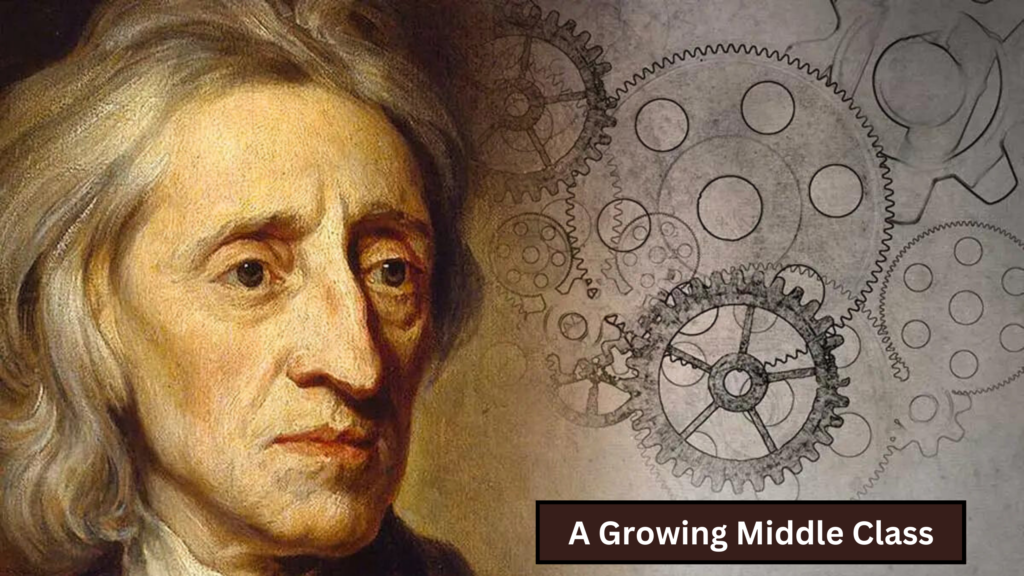
The middle class was a new social group that emerged in the 18th century.
- They had become wealthy by expanding their overseas trade and producing goods such as woollen and silk textiles. Aside from merchants and manufacturers, there were educated lawyers and administrative officials. They believed that no social group should be privileged by birth.
- Philosophers such as John Locke, Jean Jacques Rousseau, and Montesquieu believed that the revolution was solely the fault of the middle class.
- They spread the ideas of liberty, equal rights, and equal opportunities for all.
The Ideas of Philosophers were as follows –
- In his Two Treatises on Government, John Locke criticised the doctrine of the monarch’s divine and absolute right (king).
- Rousseau proposed the formation of a government based on a social contract between people and their representatives in his book “The Social Contract.”
- In his book ‘The Spirit of the Laws, Montesquieu proposed the concept of separation of powers among the legislature, the executive, and the judiciary.
- After the thirteen colonies declared their independence from Britain, the United States adopted this form of government.
These ideas were disseminated to the public via books and newspapers. The news that Louis XVI intended to raise taxes to cover the state’s expenses sparked public outrage and protest against the privilege system.
The Outbreak of the Revolution

- On May 5, 1789, Louis XVI convened an assembly of the Estates General to consider new tax proposals. The representatives of the first, second, and third estates were sent.
- The first and second estates each sent 300 representatives, who sat in rows on two sides, facing each other.
- The third estate dispatched 600 delegates.
- They were more prosperous and educated than members of the first and second estates, but they faced discrimination and had to sit in the back. Peasants, artisans, and women were denied access to the assembly, but they were able to send their demands and grievances through representatives.
- The members of the third estate demanded that voting be done as a whole assembly, with each member having one vote.
- However, the king rejected this proposal, and members of the third estate protested by walking out of the assembly.
National Assembly of Third Estate
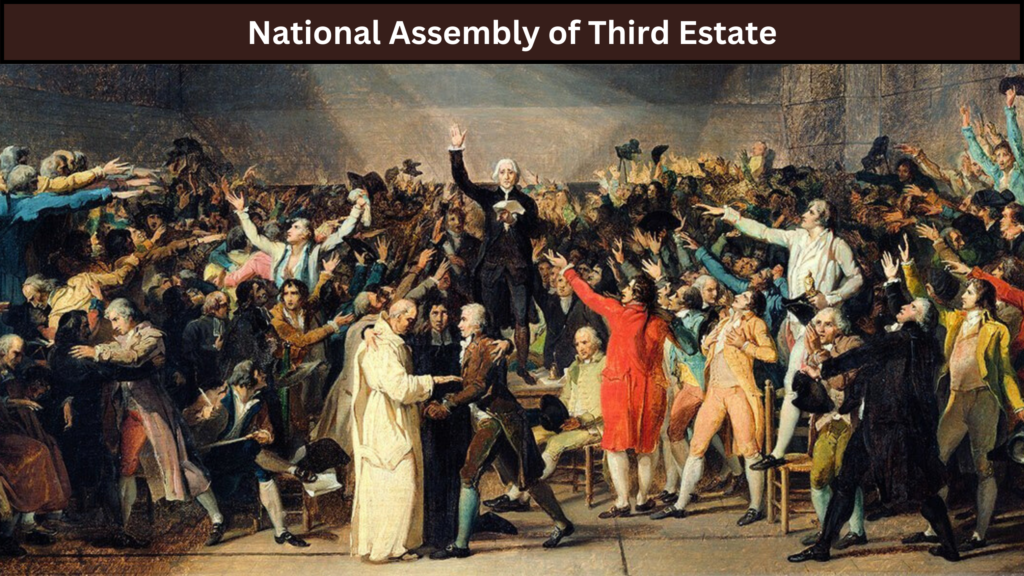
- The representatives of the third estate met in the hall of an indoor tennis court in Versailles on June 20, 1789. They established a National Assembly.
- They also stated that they would draught a new French Constitution that would limit the monarch’s powers. Mirabeau and Abbé Sieyes led the third estate representatives.
- Mirabeau was born into a noble family but rejected his feudal privileges.
- Abbe Sieyes started out as a priest. He authored the influential booklet ‘What is the Third Estate?
Revolt Starts at the Bastille
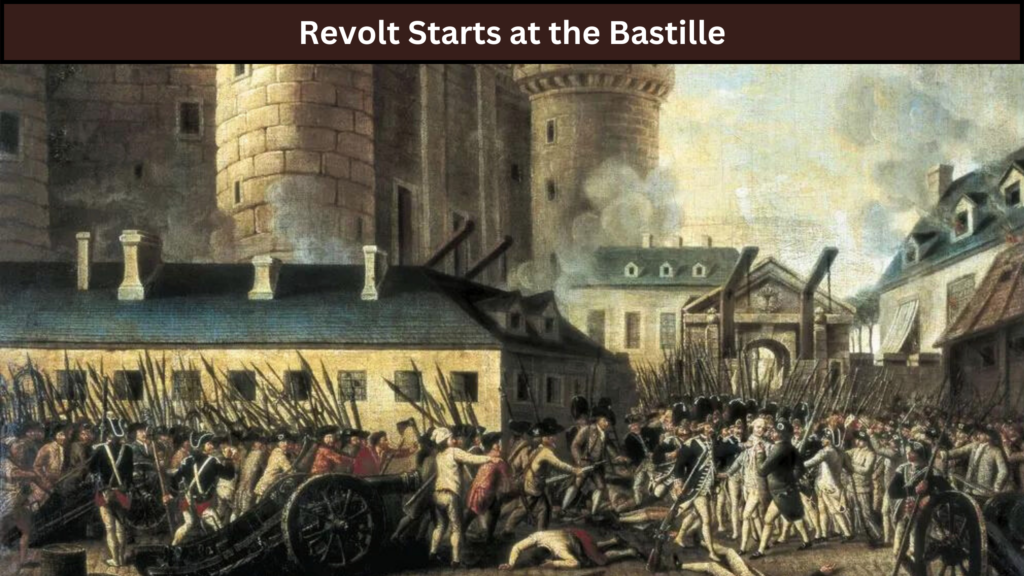
- In France, the harvest was severely harmed due to the harsh winter, resulting in an increase in bread prices. The bakers took advantage of the situation and stored supplies. Crowds of angry women raid the shops after spending hours in long lines at the bakery.
- An enraged crowd destroyed the Bastille on July 14, 1789. The Bastille was despised by all French people because it represented the king’s domineering power. Rumors spread from village to village in the countryside.
- The lords of the manor had hired a gang of robbers to destroy the ripe crops. Peasants attacked the chateau” in many areas of France after hearing this rumour. The peasants looted stored grain and burned documents containing manorial dues records.
- As a result of all of this, a large number of nobles relocated to neighbouring countries.
- Special Privileges are being phased out. Following the revolt on August 4, 1789, France under Louis XVI passed legislation abolishing the feudal system of obligations and taxes. The clergy were also forced to relinquish their privileges.
- Tithes were abolished, and the Church’s lands were seized by authority. This resulted in the government acquiring assets worth at least 2 billion livres.
France Becomes a Constitutional Monarchy
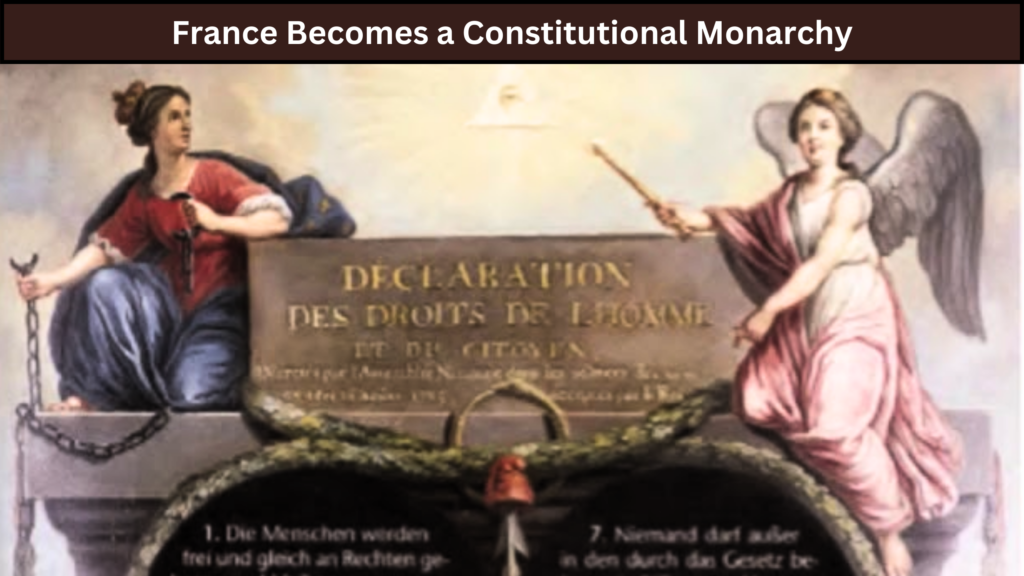
- In 1791, the National Assembly completed the draught of the Constitution. Its main goal was to limit the monarch’s powers.
- The powers were now divided and assigned to various institutions such as the Legislature, Executive, and Judiciary.
- France became a constitutional monarchy as a result of this change in power.
The Laws Made by the National Assembly
The National Assembly was to make laws under the new Constitution. The assembly was elected indirectly, which means that active citizens voted for a group of electors, who chose the assembly members. The following were the highlights of the new system:
- Men over the age of 25 who paid taxes equal to at least three days of a labourer’s wage were granted the status of active citizens, i.e. the right to vote. All of the remaining men and women were labelled as passive citizens.
- A man had to be a member of the highest tax bracket to qualify as an elector and then as a member of the assembly.
- The Constitution began with a Declaration of Man’s and Citizen’s Rights, which included the right to life, freedom of speech, freedom of opinion, and equality before the law.
- These were established as ‘natural and inalienable’ rights, and it was the state’s responsibility to protect them.
France Abolishes Monarchy and Becomes a Republic
The developments in France concerned the rulers of France’s neighbouring countries. They planned to send troops to quell the events that had been going on since 1789. In April 1792, the National Assembly declared war on Prussia and Austria. Thousands of volunteers enlisted in the army to serve in the National Assembly.
- The Marseillaise, written by poet Roget de L’Isle, was a patriotic song sung by volunteers. Volunteers from Marseilles sang it for the first time as they marched into Paris. It later became France’s National Anthem.
- Because the Constitution of 1791 granted political rights only to the wealthy, a large segment of the population was persuaded to continue the revolution.
- People used to meet in political clubs to discuss government policies and plans of action. The Club of Jacobins, named after the convent of St Jacob in Paris, was the most successful of these.
The Jacobin Club
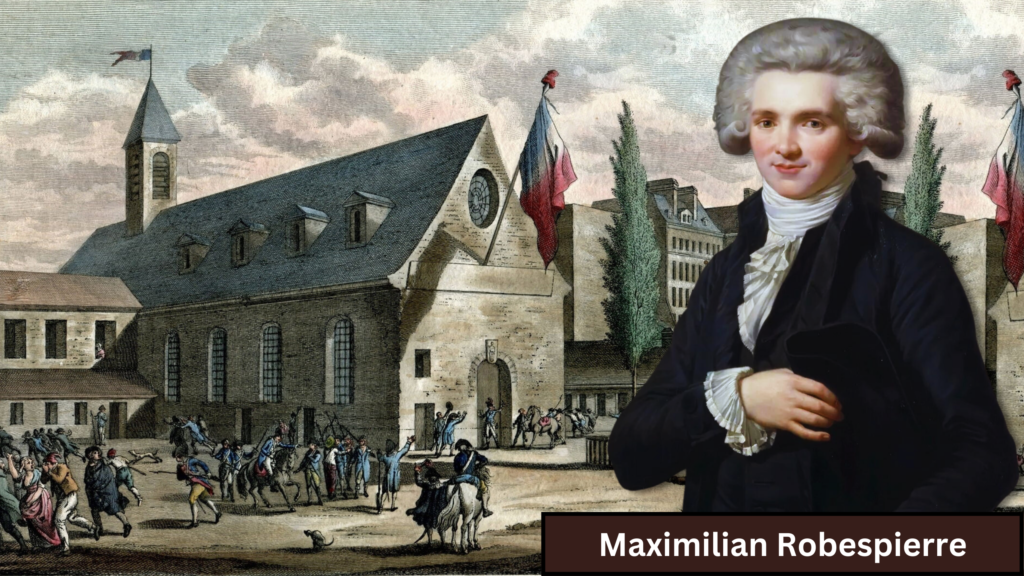
Members of the Jacobin club were mostly from the lower classes of society. Shopkeepers, artisans, cooks, shoemakers, watchmakers, printers, servants, and day labourers were among them. Maximilian Robespierre was their leader.
- They dressed in long striped trousers, similar to those worn by dock workers. It was a way of declaring the end of the power of those who wore knee breeches.
- They became known as sans-culottes, which translates as “people without knee breeches.” Sans-culottes men wore a red cap, which represented liberty.
The Convention: Assembly Elected for the First Time The Jacobins attacked the Tuileries Palace with a large number of Parisians on August 10, 1792. They assassinated the King’s guards and held the King hostage for several hours. The assembly later voted to imprison the royal family.
- Elections were held in August 1792, and now all men over the age of 21 could vote regardless of their wealth.
- The newly elected body was known as the Convention. On September 21, 1792, the monarchy was abolished, and France was declared a republic.
- A court sentenced Louis XVI to death on the charge of treason.” Louis XVI was publicly executed on January 21, 1793, at the Place de la Concorde.
- After some time, Queen Marie Antoinette was sentenced to death as well.
The Reign of Terror
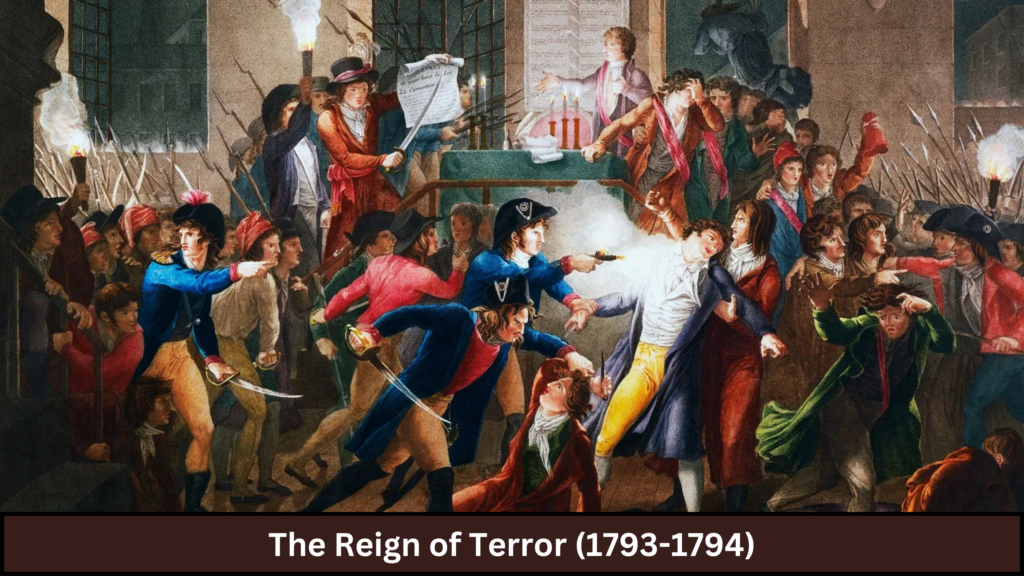
In France, the years 1793-1794 are known as the “Reign of Terror.” This was due to Robespierre’s policy of strict control and punishment. The following events occurred during this time period:
- A revolutionary tribunal arrested and tried many people (court). All those considered enemies of the republic by Robespierre (such as ex-nobles, clergy, and political party members) were included. They were guillotined if found guilty by the court.
- Peasants were forced to transport their grain to cities and sell it at government-set prices.
- The use of costly white flour was prohibited. Rationing is applied to meat and bread.
- People were forced to eat the pain legality (equality bread), a whole wheat loaf.
- Instead of Monsieur and Madame, all French men and women were referred to as Citoyen and Citoyenne (citizen).
- Churches were closed, and their structures were converted into barracks or offices.
- Harsh policies drove even his supporters away in the end. He was finally convicted by a court and guillotined in July 1794.
A Directory Rules France
Following the Jacobins defeat, the wealthier middle classes seized power. A new Constitution was enacted, which Under the Jacobins, these councils appointed a Directory, an Executive made up of five members.
- The Directors occasionally clashed with the Legislative Councils, and the councils frequently dismissed the Directors.
- This political unrest paved the way for Napoleon Bonaparte, a military dictator, to rise to power.
- Despite all these changes, the ideals of freedom, equality and fraternity remained inspiring ideals that motivated political movements for France and the rest of Europe.
Women in Revolution
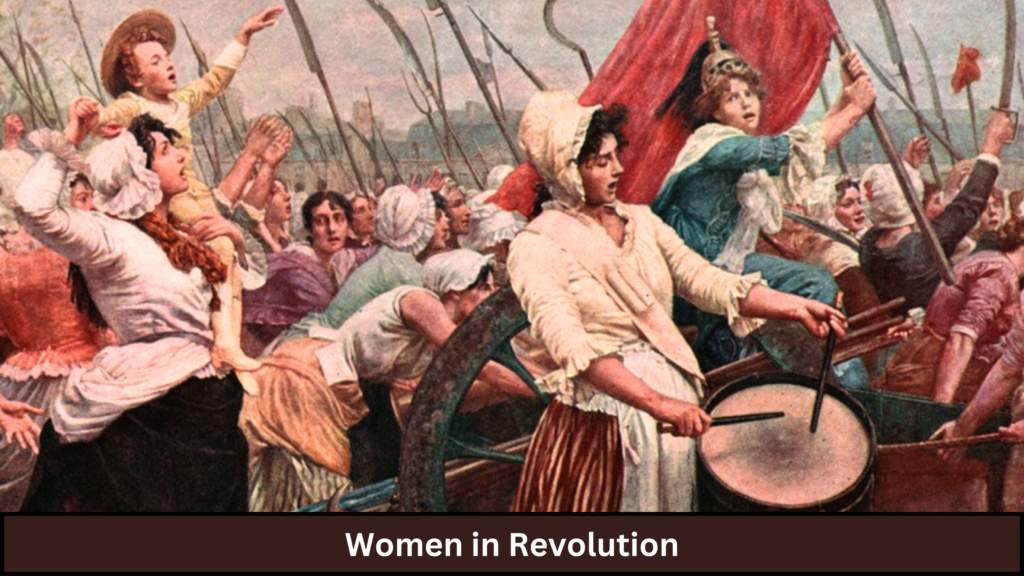
Women played a vital role in the French Revolution. Most of the women belonging to the third estate worked for a living.
- They worked as seamstresses or laundresses, sold flowers, fruits, and vegetables at markets, and were employed as domestic servants in wealthy families, among other things. Only the daughters of nobles and the wealthier members of the third estate were permitted to attend a convent.
- Aside from caring for their families, French women had to cook, fetch water, wait in lines for bread, look after the children, and so on. Their pay was always lower than that of men. Women in France were dissatisfied with the 1791 Constitution.
- It reduced them to being passive citizens with no political clout. Women established political clubs and newspapers to express their opinions and demands.
- There were about sixty women’s clubs in French cities, the most famous of which was “The Society of Revolutionary and Republican Women.”
Laws Passed to Improve Women’s Lives
Initially, laws were enacted to improve the lives of women. The changes brought about by these laws were
- With the establishment of state schools and a system of compulsory education for girls, women gained access to education.
- Women could no longer be forced into marriages by their fathers and could marry as they pleased.
- Marriage was now a civil law contract that could be registered.
- Divorce became legal. Both men and women are eligible to apply.
- Women could go to college, become artists, or start their own businesses.
French Women Got the Right to Vote
During the Reign of Terror, the government closed women’s clubs and prohibited their political activities. A large number of prominent women were arrested and executed. During the late nineteenth and early twentieth centuries, an international suffrage movement fought for women’s voting rights and equal political rights.
Finally, French women gained the right to vote in 1946.
Olympe de Gouges (1748-1793)
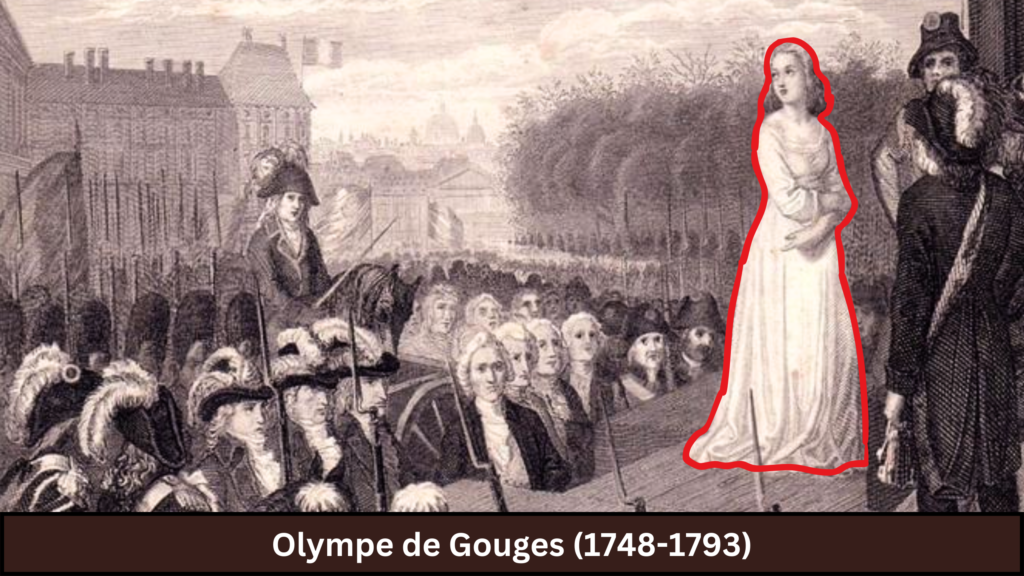
Olympe de Gouges (1748–1793) was a politically active woman in revolutionary France. She opposed the Constitution and the Declaration of the Rights of Man and Citizen. She addressed the Queen and members of the National Assembly in her Declaration of the Rights of Woman and Citizen in 1791.
Olympe de Gouges chastised the Jacobin government in 1793 for forcibly closing down women’s clubs. The National Convention tried her and charged her with treason. She was executed not long after.
The Abolition of Slavery
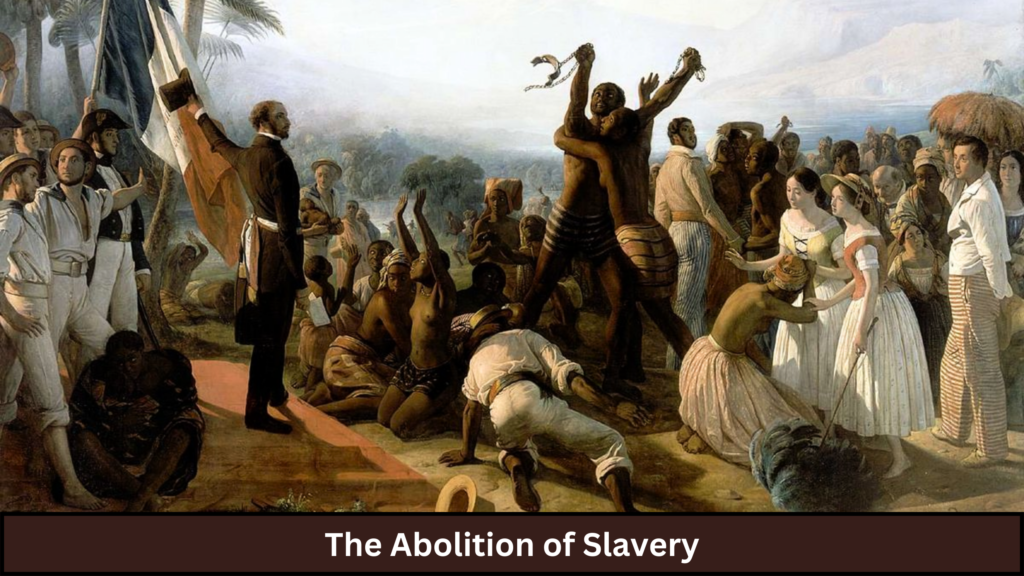
The Jacobin government’s most significant social reform was the abolition of slavery in French colonies. Martinique, Guadeloupe, and San Domingo, for example, were important suppliers of tobacco, indigo, sugar, and coffee.
- The French needed workers for their colonies plantations, but Europeans did not want to work in distant, unknown lands.
- In the 17th century, a three-way slave trade began between Europe, Africa, and America. This was referred to as the triangular slave trade.
- French merchants travelled to the African coast from the ports of Bordeaux or Nantes, where they purchased slaves from local chieftains.
- The flourishing slave trade was responsible for the economic prosperity of these port cities. Slavery received little criticism in France throughout the 18th century.
- After lengthy debates, the National Convention passed legislation in 1794 that made slavery illegal and freed all slaves in France’s overseas colonies.
- After ten years, Napoleon reinstated slavery in order to appease plantation owners who saw enslaving African blacks as their right.
- These slaves were referred to as “African Negroes. Slavery was finally abolished in the French colonies in 1848.
The Revolution and Everyday Life
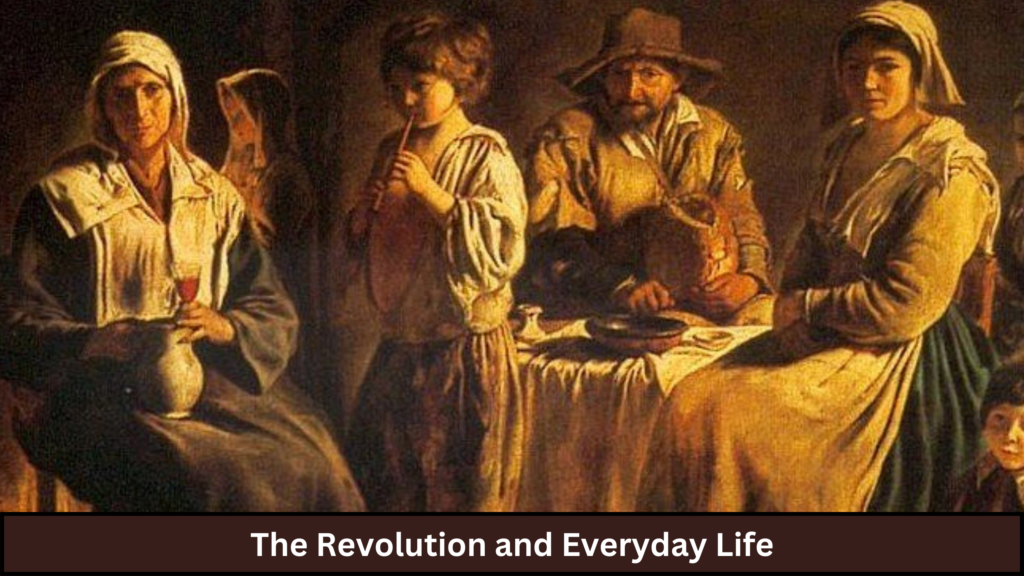
Many changes occurred in the lives of women, men, and children in France after 1789.
- The abolition of censorship was a significant law that went into effect in 1789.
- Censorship required that all written material and cultural activities be performed or published only after being approved by the king’s censors. With the end of censorship and the adoption of the Declaration of the Rights of Man and Citizen, freedom of speech and expression became a natural human right.
- This resulted in the proliferation of newspapers, pamphlets, books, and printed images. The freedom of the press allowed people to express their views and counter-arguments.
Conclusion
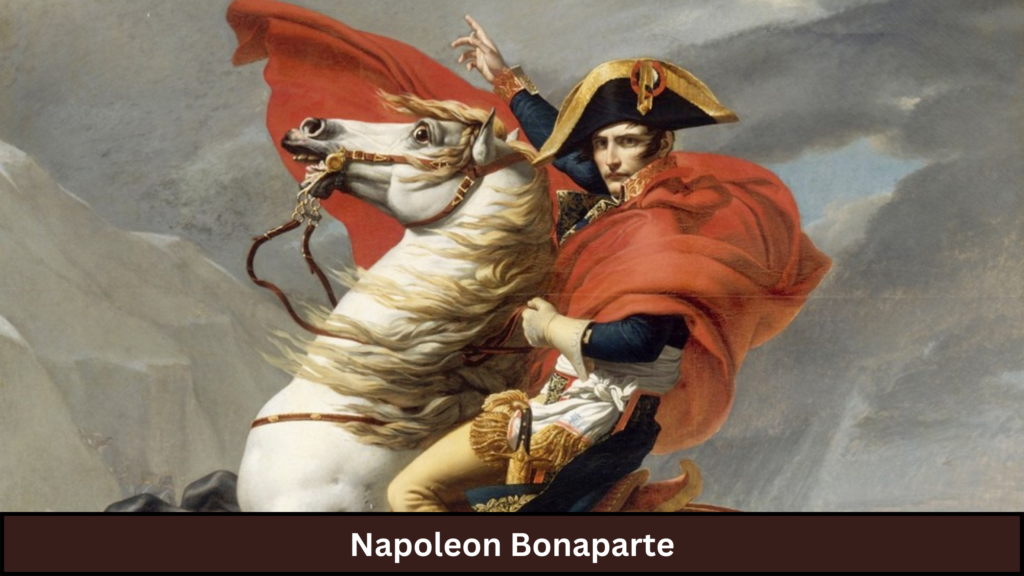
- Napoleon Bonaparte, a well-known French general, crowned himself Emperor of France in 1804.
- He conquered neighbouring European countries, deposed dynasties, and established kingdoms in which members of his family resided.
- He saw himself as a modernizer of Europe. He enacted numerous laws, including the protection of private property and a uniform system of weights and measures provided by the decimal system.
- Many people saw Napoleon as a liberator who would bring freedom to the people. However, his army quickly became regarded as an invading force throughout the world.
- Napoleon was finally defeated at Waterloo in 1815. Even after his defeat, Napoleon’s ideas about liberty and modern laws persisted in other parts of Europe.
The most important legacy of the French Revolution, which spread throughout Europe, was the ideas of liberty and democratic rights. - This resulted in the abolition of feudalism and the liberation of colonised nations.
- Some of the Indians who were inspired by the ideas of the French Revolution included Tipu Sultan and Raja Rammohan Roy.

